Pope Benedict XIV (1675–1758) – modernizer, reformer, a fierce enemy of Jews and Freemasons
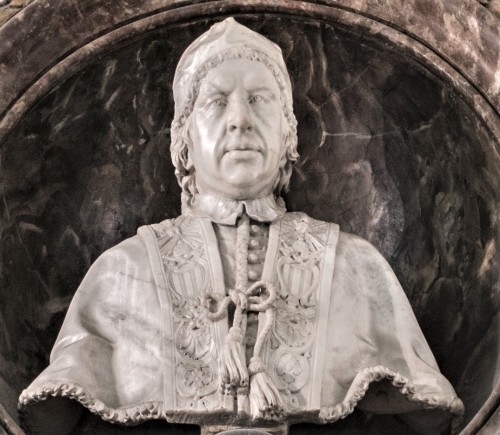
Bust of Pope Benedict XIV, Musei Capitolini
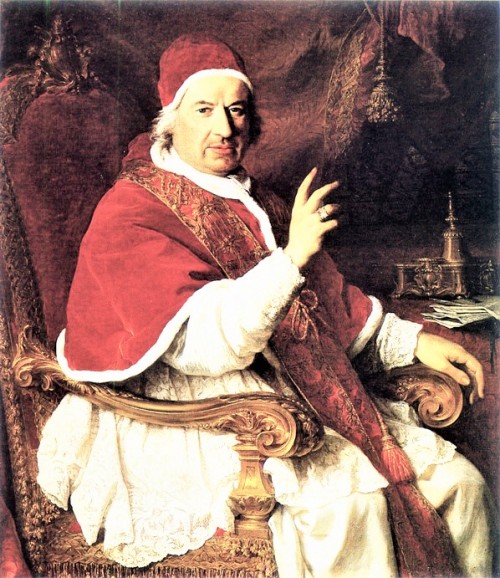
Portrait of Pope Benedict XIV, Condé Museum, Château de Chantilly, pic. Wikipedia
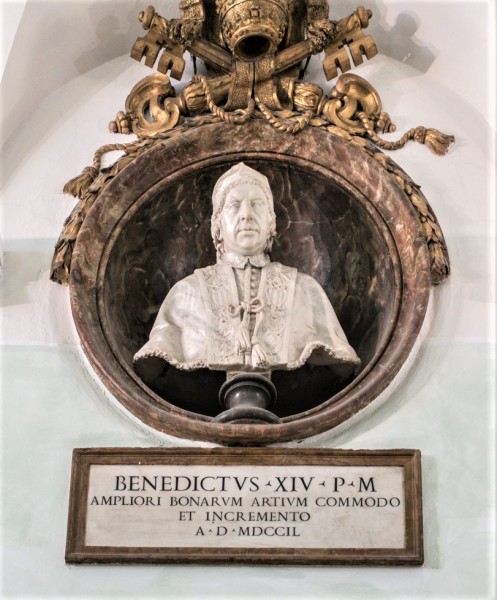
Bust of Pope Benedict XIV, Musei Capitolini
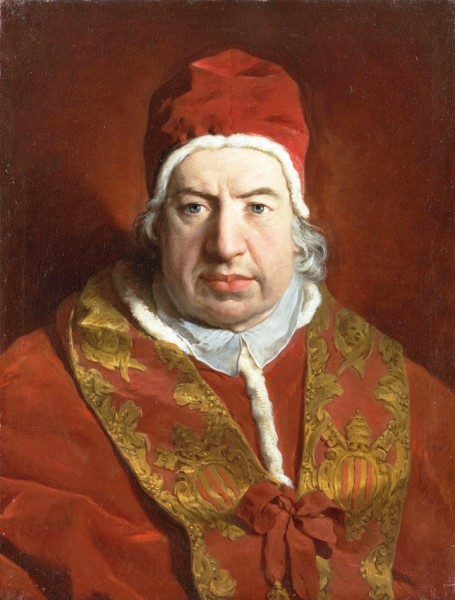
Portrait of Pope Benedict XIV, Pierre Subleyras, 1746, Metropolitan Museum of Art, New York, pic. Wikipedia
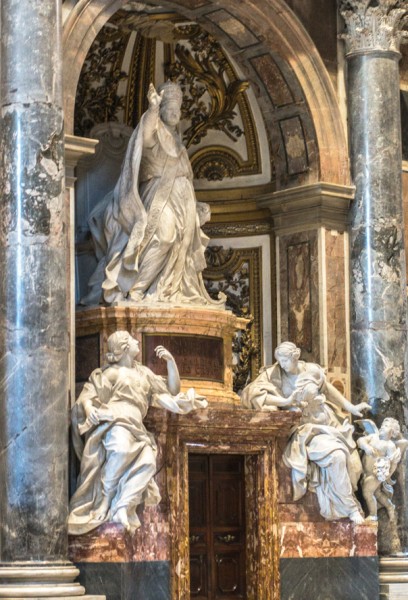
Tombstone of Pope Benedict XIV, Basilica of San Pietro in Vaticano
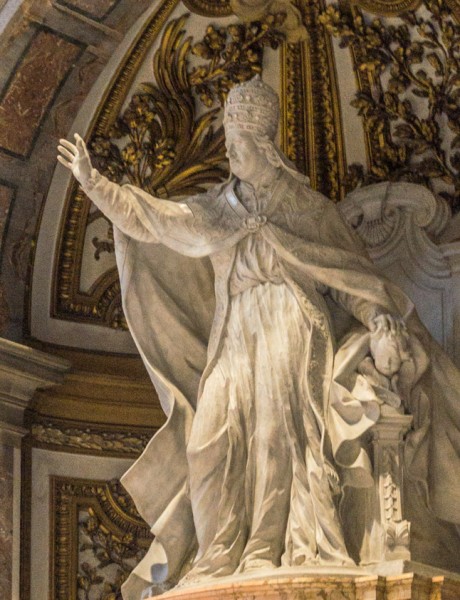
Tombstone of Pope Benedict XIV, fragment, Basilica of San Pietro in Vaticano
The conclave called after the death of Pope Clement XII at the beginning of 1740 could not come to a conclusion. The reason for this was the struggle between several rivaling fractions. One day, as an anecdote would have it, one of its participants was to say in a characteristic for him joking manner “If you wish to elect a saint, choose Gotti; a statesman, Aldrovandi; an honest man, me". Apparently, his words made an impression since their author, who had not been considered until then, the archbishop of Bologna Prospero Lambertini, after a conclave that lasted more than half a year, ultimately became the new bishop of Rome.
The conclave called after the death of Pope Clement XII at the beginning of 1740 could not come to a conclusion. The reason for this was the struggle between several rivaling fractions. One day, as an anecdote would have it, one of its participants was to say in a characteristic for him joking manner “If you wish to elect a saint, choose Gotti; a statesman, Aldrovandi; an honest man, me". Apparently, his words made an impression since their author, who had not been considered until then, the archbishop of Bologna Prospero Lambertini, after a conclave that lasted more than half a year, ultimately became the new bishop of Rome.
This educated lawyer and a proponent of science, also known as „the enlightened" pope, sat upon St. Peter's throne for the next eighteen years, reforming his office, but most of all bringing financial stability to the State of the Church. Its finances had for a long time been in a state of disaster. The first step in order to improve this state of things was doing away with nepotism. The second – a modest lifestyle both of the head of the Church, as well as his reduced to a bare minimum court, while also eliminating all signs of luxury and resigning from the apanages of his collaborators.
During his pontificate, Benedict XIV gained renown at the courts of Europe through his conciliation, even towards his enemies, meaning those favoring the Reformation. A further testimony to his openness is giving permission to print the works of Galileo as well as making attempts to have the works of Copernicus removed from the list of prohibited books, which finally took place only fifty years after the pope's death. His interest in science and its support gained him many supporters among the then intellectuals such as Voltaire and Montesquieu, who even called him "the pope of the learned". However, there were borders that even the pope did not cross, even strengthening them. During his pontificate, the cult of the Blessed Andreas Oxner was confirmed (later done away with in 1994). Oxner was a child, who was allegedly a victim of a ritual murder committed by the Jews in the XV century (Bulla Beatus Andreas).

And while the pope did not particularly like Jews, who according to him had a bad influence on Catholics and should not have the possibility to hold public office, he openly fought against and condemned Freemasons, threatening excommunication to all who would join secret freemason societies.
Lowering taxes in the State of the Church, disciplining bishops, and a modest lifestyle gained the pope popularity just as had his sense of humor, jovial character, and unrefined language not shying away from vulgarisms. In a Bolognese dialect, he swore like a sailor, not caring much for the circumstances or the place. The Roman populace, also wont of swearing in their local dialect, took kindly to the pope, who would use profanity as an exclamation mark, however, church dignitaries were not so understanding. One of them was even tasked with pulling on the pope's robe every time Benedict took his verbal expressions too far. One anecdote recalls a morning council, during which the pope angered by the news of fire in the city, issued one of his favorite curses (cazzo!). The irritated master of the ceremonies, who would unsuccessfully pull Benedict’s robe, when the pope once again commented on bad news with his favorite expression, was finally put in his place when the pope said: Cazzo, cazzo, cazzo I intend to sanctify the word and grant plenary indulgence to anyone who says it at least ten times a day”.
Another weakness of the pope was snuff. He used it so often and so willingly that we will even see a snuffbox on his funerary monument (The Funerary Monument of Pope Benedict XIV). Taking snuff, which meant inhaling it through the nose was at that time something normal, especially since it was considered a great treatment against headaches, toothaches, a cold, and constipation. It was Pope Benedict XIII who allowed clerics to take snuff, however, recommending not to use it during prayers. This permission should not surprise us, because this was not only a fashionable drug, but also an important income source for the State of the Church, in addition to providing employment for quite a large group of the Roman populace. In Rome itself, in the second half of the XVIII century, there were three manufacturing plants active, producing tobacco products (cigarillos, cigars, and snuff).

We can also thank Benedict XIV for saving the Colosseum from being taken apart completely, as it had for years been treated as a stone quarry from which material was obtained to construct the palaces of the Roman aristocracy. The pope forbade further demolition, and in order to dispel any doubts, he entrusted the area to the care of the saints, who had allegedly been martyred there. The construction of fourteen chapels of the Way of the Cross completed the task of its protection.
Despite financial problems, with which he struggled, Benedict XIV would be remembered in history as a patron of art and science. He established four papal academies, created new faculties at the La Sapienza University – mathematics, experimental physics, and chemistry, and acquired new volumes for the papal library, and new works of art for the Capitoline Museum. In his hometown of Bologna, at the local university, he established the first faculty of obstetrics, and also a woman, Maria Gaetana Agnesi had become the head of a department in the Faculty of Mathematics, during his pontificate.
The pope also spared no expense for the restoration and modernization of the crumbling Roman churches, sometimes ordering them to be completely reconstructed in a new style. In the face of the approaching Jubilee Year (1750), when the city was to show its new face, this was a very important issue for the Church.
Construction, modernization, and restoration works in Rome:
- Modernization and reconstruction of the Churches of Sant’Appollinare, Santa Brigida, Sant’Agata in Trastevere, Santi Marcellino e Pietro
- Funding the figure of St. Michael the Archangel (Peter Anton von Verschaffelt) adorning the Sant’Angelo Castle
- Continuation of the construction of the di Trevi fountain, finally completed in 1762.
- Conservation of the dome of the Basilica of San Pietro in Vaticano and restoration and modernization works in the Basilica of Santa Maria Maggiore and Santa Croce in Gerusalemme.
If you liked this article, you can help us continue to work by supporting the roma-nonpertutti portal concrete — by sharing newsletters and donating even small amounts. They will help us in our further work.
You can make one-time deposits to your account:
Barbara Kokoska
BIGBPLPW 62 1160 2202 0000 0002 3744 2108
or support on a regular basis with Patonite.pl (lower left corner)
Know that we appreciate it very much and thank You !






















